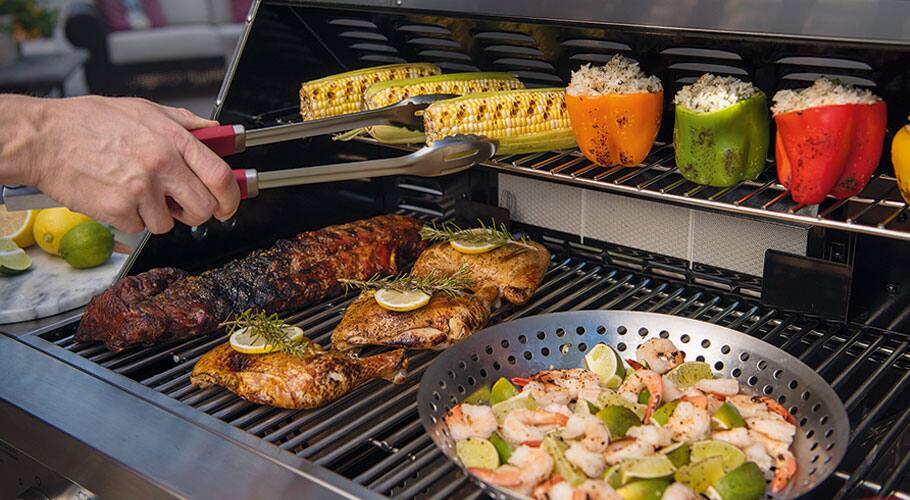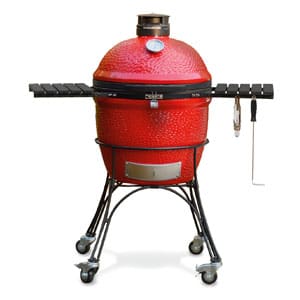
Be skilled on the grill
Pro tips to get the most out of any type of grill
When it comes to backyard grilling, there are a couple of things that Costco member Jeremy Yoder, host of the popular YouTube channel Mad Scientist BBQ, thinks will improve everyone’s game. On his show, Yoder, who lives in Crestwood, Kentucky, and holds a bachelor’s degree in biochemistry, breaks down the science behind great grilling techniques. He believes that learning to control the temperature of your grill and accurately tracking the internal temperature of what you’re cooking will vastly improve your grilling.
Bring the heat
“If you can control the temperature of your grill, you’re already ahead of the game,” says Yoder, whose fascination with grilling began when he was 12. “This is true no matter what kind of grill you have, whether it’s a Kamado, charcoal, pellet or gas grill.”
He says grillers should focus on three target temperatures: low and slow heat (250 F), medium (350 F) and “nuclear”— as hot as your grill goes.
“You’ll use the low and slow temperature of 250 degrees for gentle cooking, and it’s going to bring the meat to its final temperature,” Yoder explains. What you want to avoid with low and slow cooking is lean cuts, he says, as it tends to dehydrate the surface of the meat and leave a layer of desiccated, tough bark.
Medium heat is perfect for burgers, chicken and vegetables. “Done properly, you’ll get a little bit of browning, but you don’t char vegetables, chicken and so forth,” Yoder says. “You’ll get the flavor on the outside, which is the whole purpose of grilling.”
And what about that third temperature: nuclear? “It’s going to be the most intense heat you can get from your grill, and it will provide the most intense flavors of whatever you’re cooking,” he says
This heat is used to achieve the Maillard reaction, a chemical change in food caused by the heat from a grill. It breaks down food’s proteins into amino acids, which react with sugars present in the food, elevating its taste, aroma and appearance. It’s responsible for the delicious dark brown exterior of seared meat and other foods.
“If you master dialing in these three temperatures, 90% of the battle is won,” Yoder says.
Temp, not time
Yoder’s second piece of advice is an insider tip, literally. He says that knowing the internal temperature of whatever you’re cooking takes the guesswork out of deciding when your food is done. “A lot of people want to grill a steak for eight minutes on one side and then four minutes on the other side,” Yoder says.
The problem with trying to use time as a measure for doneness is that it can’t account for the many variables, such as the fat marbling and the consistency of muscles from one type of meat to another. “The thickness will vary from one cut to the next. Time is an approximation,” he says.
For the best results, he suggests using a digital instant-read thermometer to measure the inside temperature of whatever you are cooking. “You poke it in and you have hard data to tell you if you’re on the right track or not,” he says. “It also addresses the issue of food safety with things like chicken and other poultry. You can know for a fact, ‘Oh yeah, that’s 167 degrees. It’s totally safe. I don’t have to worry about feeding this to my kids.’ ”
Yoder notes, “I’m trained in science and try to apply scientific principles in order to improve my cooking. You can end up in the same place by cooking for thousands of hours, or by understanding the science behind what you’re doing and with those principles drastically shorten the learning curve.”

Jeremy Yoder, host of the YouTube channel Mad Scientist BBQ, says that you can get great results with any grill: There are benefits and drawbacks to all of them.
He says, “Kamados [such as the Kamado Joe Classic II, Item 2127175, shown above] don’t have a lot of space and they’re very heavy, but they are good at low and slow cooking and grilling, making them very versatile.”
Yoder says pellet grills also excel at low and slow cooking, but are not great for high-heat searing, while with a charcoal grill, you must stage the charcoal so that it will burn for a long time at a steady rate.
Finally, he says, “Gas grills are very convenient, but you’ll need to dial in the key temperatures and set up the grill so that you’ve got a direct-heat side for searing and an indirect side, where there’s space between the flames and the surface where your food cooks.”—WF
Costco Connection: You’ll find a selection of grills and grilling tools, including digital meat thermometers, and a wealth of quality food for grilling, in Costco warehouses and at Costco.com. Food can be purchased for delivery with Costco Grocery at Costco.com.



